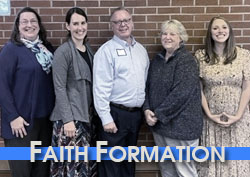Parish Self-Assessment Tool

Growing as the Body of Christ
“Faith formation is a life-long process. It will not only embrace existing programs such as religious education and youth ministry, but also faith formation efforts yet to be developed. It will be directed toward all age groups as well as to the needs of various audiences.”
Recommendations for Faith Formation from Diocese of Erie Pastoral Planning (2018).
Why use this self-assessment?
The model of lifelong faith formation was the response to the call articulated out of diocesan Pastoral Planning. The model, and this corresponding tool, allow us to see our people and their diverse needs across different stages of life through a standard metric. The self-assessment tool can be a checkpoint for parish ministries, providing a lens of how effectively they may respond to the spiritual development needs of your people.By looking broadly at lifelong faith formation efforts at your parish, you can take time to celebrate and thank God for what is bearing fruit and notice any gaps. And, this tool can help you discern and hear God’s call for your parish, including how to invest your energy into the most effective and high-impact ways to reach people whose needs are not currently met in intentional ways.
The self-assessment neither advocates for specific programs, nor claims that every parish should look the same. Rather, it provides flexibility to help you examine the needs, gifts, and growth areas for your parish family.
Parish self-assessment tool
How to use this self-assessment?
First, complete the parish profile. Then, find a small review team whose knowledge represents an understanding of lifelong faith formation offerings at your parish. Next, establish your goals for the review process, and then review the assessment questions for each stage of life. How does your parish respond to the spiritual development needs of people in that group? Lastly, you are welcome to reach out to the Faith Formation team, either for help along the way, a macro-level review of your results, or planning how to move forward.
What time commitment will this require?
The amount of investment your team puts in will determine the level of impact of your work. We recommend 5-10 hours of group work, which can be done over of several weeks or months.• 3, 1-hour conversations can probably give you a good sense of where your gifts and gaps are.
• 4, 2-hour conversations (1 hour of discussion on each of the 8 stages of life) can open up deep dialogue on what lifelong faith formation looks like, and could look like, at your parish.
With either option: Plan on 1-2 hours of debrief and planning your next step, to help your fruitful areas continue to flourish and discern a gap you feel called to address.
We also provide two different self-assessment tools. The first is titled, “Expedited Parish Self-Assessment” this tool has fewer questions per age group, but requires the same steps as the “Comprehensive Parish Self-Assessment 2020.” Please review both documents before making a final decision.
What supports can I expect from Faith Formation at the diocese?
• Step-by-step tutorial videos below will walk you through each step of the process • Support thinking through who the best team would be (i.e. Pastor + staff, vs. Pastor + pastoral council, vs. Pastor + a few knowledgeable parishioners)
• On-call support: Schedule a call to help throughout or after the process.
• The Best Practices Tool is a curated list of best practices for high-impact faith formation at each stage of life. Choose one of these 16 ideas (2 suggestions for each age group) for “plug-and-play,” to help build a new intentional ministry for a particular age group.
Tutorial videos
This video accompanies section: Lifelong Faith Formation: Self-Assessment for Parishes (pages 2-3).
This video accompanies sections: Parish Profile, Parish Self-Assessment Process, and Parish Self-Assessment Team (pages 4-6).
This video accompanies section: Shared Mission (page 7).
This video accompanies section: Review of Demographics (page 8).
This video accompanies sections: Guiding Questions and each Age Group Chart (pages 9-18).
This video accompanies section: Prioritize Challenges (page 19).

